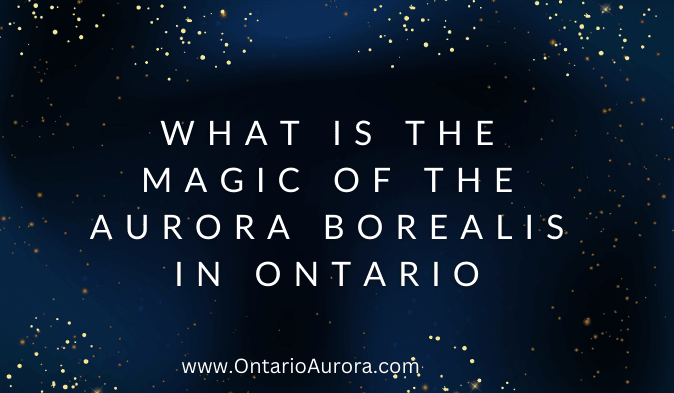
Aurora Borealis in Ontario: The aurora is a natural light that is shown in the sky at night. It is made up of bands of green, red, or purple lights that move around and change colour over time.
It is most often seen near the Arctic and Antarctic rings, which are also called “auroral zones.”
Alaska, Canada, Iceland, Scandinavia, Finland, and Russia are often good places to see the northern lights, also known as aurora borealis. Antarctica, New Zealand, and Australia are good places to see the southern lights, also known as Aurora Australis.
But when there is a lot of geomagnetic action, the auroral zones get bigger and move closer to the equator. Low-latitude people, like those in the UK, may also have a better chance of seeing the aurora at these times.
The Earth’s magnetic field can be changed by strong sun activity, which can cause the northern and southern lights to shine brightly.
Things on the sun should be at their most active in 2024, which means that the clouds might be nice this year.
Why do the northern lights show up?
The aurora we see moving in the sky at night is caused by things going on in the sun. Ionized gas that is very hot makes up the Sun.
The Sun constantly sends out a stream of charged particles called the solar wind.
The speed and power of the solar wind can change depending on what’s going on in the sun. Structures on the sun’s surface, like coronal holes and active regions, cause this activity.
Coronal holes are short-lived features that can appear on the Sun. This is a very large area where the Sun’s magnetic field weakens and lets the fast solar wind flow out into the solar system. It might take this fast solar wind three days to get to Earth.
On August 31, 2012, a coronal mass ejection shot into space. There is a picture of Earth on top of the coronal mass ejection to show how big it is compared to Earth, NASA, GSFC, and SDO.
Strong and complicated magnetic fields can be found in active places on the Sun. On the sun’s surface, these spots look like dark spots called “sunspots,” and they can cause big explosions like solar flares and coronal mass ejections.
Coronal mass ejections are huge clouds of charged particles that are thrown out by the Sun. They move very quickly. It could take them one to three days to get to Earth.
If these “storms” in the sun are pointed at Earth, the solar wind will combine with the planet’s magnetic field and send particles of the wind toward the poles.
These charged particles crash into atoms in the Earth’s atmosphere. The energy released by these collisions is turned into light, which is what makes the aurora glow.The colours that show up depend on what gases are in the air.
When solar particles hit oxygen, they create green aurorae. But when they hit oxygen at higher levels, they create red aurorae. When things hit nitrogen, they give them blue and purple shades.
What does the solar cycle mean?
How many sunspots you can see on the Sun shows how active it is. The activity cycle lasts about eleven years. Solar minimum is a time when there aren’t many sunspots and the sun’s activity is generally low.
During solar maximum, there are a lot of sunspots, which makes solar storms happen more often. We know these solar storms can mess up the Earth’s magnetic field.
Since the 1700s, people have kept track of the sun’s movements. A group of experts said back in 2020 that the current solar cycle (solar cycle 25) would be pretty weak, just like the last cycle. Around July 2025, the sun was supposed to be at its busiest.
The National Oceanic and Atmospheric Administration’s Space Weather Estimate Centre made a new estimate for solar activity in October 2023.
This predicted a faster and stronger peak of activity, with the sun’s hottest days happening between January and October 2024. Because of this, we think 2024 will be a good year to see the aurora.
When can people in Ontario see the Northern Lights?
From September to March, the best time to see them is from 10pm to 3am. The nights are longer and darker during these months, and the sun is active, which is what makes the lights happen.
Where to see the Northern Lights in Ontario?
These are some of the best places in Ontario to see the aurora:
- Algonquin Provincial Park: This huge park is out of the way of the city lights and has clear skies. A lot of lodges give packages to see the aurora.
- Lake Superior Provincial Park: There are miles of untouched shores and secluded beaches that are great for taking pictures.
- Foleyet is a small town in northern Ontario that is wrapped in thick forest. The dark clouds are great, and the places to stay are not too expensive.
- Manitoulin Island: The island’s rolling hills, woods, and more than 100 miles of shoreline make it easy to find a quiet place to watch the scenery.
- Temagami is another rough northern spot that you can see from hotels, resorts, or by camping out under the stars.
Can you see the Northern Lights from Niagara Falls?
It is possible. The bright lights from the city and attractions in this area make it hard to see the Aurora. Get away from big cities and towns for at least an hour if you want to see the lights.
When in Ontario is the best time to see the Northern Lights?
As was already said, the best chances are in the fall and winter, especially around the September and March equinoxes. The lights, on the other hand, are turned on by the sun, so they can show up at any time, even in the summer!
The important thing is to find a dark place, look up, and check the geomagnetic activity report for Ontario. You might see a show if you wait and are lucky.
Many people have on their “bucket list” seeing the Northern Lights in person. Ontario has many beautiful provincial parks, natural scenery, and dark skies that make it easy for brave aurora hunters to see this amazing natural show.
So get ready to be amazed by the Aurora Borealis. Don’t forget to bring your camera and warm clothes.
Now you know everything you need to know to see the Northern Lights this season in Ontario. Get cozy, grab your camera, and find a dark, out of the way place away from the city lights. Then wait for the beautiful lights to dance across the sky.
If the Kp index shows that the conditions are good and the solar wind is moving, you should go to one of the best places to see the sun, such as Algonquin Park, Muskoka, or Manitoulin Island.
The view will be the best in the house as you watch one of nature’s best shows. You might even see the rare red and purple auroras.
If you’re lucky, the lights will put on a show that you’ll remember for a long time. Don’t just wish you could see the Northern Lights; go to Ontario and make it happen.
Frequently Asked Questions (FAQs) about Aurora Borealis in Ontario, Canada:
What is the Aurora Borealis?
The Aurora Borealis, also known as the northern lights, is a natural light display that occurs in the Earth’s sky, primarily in polar regions. It consists of bands of green, red, or purple lights that move and change color over time.
When is the best time to see the Northern Lights in Ontario?
The best time to see the Northern Lights in Ontario is typically from September to March, especially around the equinoxes in September and March. However, auroras can occur at any time of year, even in the summer.
Where are the best places to see the Northern Lights in Ontario?
Some of the best places in Ontario to see the aurora include Algonquin Provincial Park, Lake Superior Provincial Park, Foleyet, Manitoulin Island, and Temagami. These locations offer dark skies away from city lights, providing optimal viewing conditions.
Can you see the Northern Lights from Niagara Falls?
It is possible to see the Northern Lights from Niagara Falls, but the bright lights from the city and attractions in the area may hinder visibility. For the best experience, it’s recommended to get away from big cities and towns for at least an hour to improve chances of seeing the lights.
What causes the Northern Lights to appear?
The Northern Lights are caused by charged particles from the sun interacting with the Earth’s magnetic field. When these particles collide with atoms in the Earth’s atmosphere, they emit light, creating the spectacular auroras.
How can I increase my chances of seeing the Northern Lights?
To increase your chances of seeing the Northern Lights, monitor the geomagnetic activity reports for Ontario and choose a dark, secluded location away from city lights. Additionally, consider visiting during peak aurora seasons and times of heightened solar activity.
What should I bring for Northern Lights viewing in Ontario?
When viewing the Northern Lights in Ontario, it’s important to dress warmly, as temperatures can be cold, especially during fall and winter months. Additionally, bring a camera to capture the stunning display.
Is there a specific time of night to see the Northern Lights in Ontario?
The best time to see the Northern Lights in Ontario is typically from 10pm to 3am, when nights are longer and darker. However, auroras can occur at any time during the night, so it’s worth staying alert and patient.
Are there any particular events or conditions that make the Northern Lights more likely to appear?
Increased geomagnetic activity, such as solar storms and coronal mass ejections from the sun, can enhance the visibility of the Northern Lights. Monitoring the Kp index and solar wind movements can help determine optimal viewing times.
Why are the Northern Lights sometimes different colors?
The colors of the Northern Lights depend on the types of gases present in the Earth’s atmosphere. For example, green auroras are produced when solar particles interact with oxygen, while red auroras occur when they interact with oxygen at higher altitudes. Nitrogen can produce blue and purple shades.
You will be amazed after knowing Aurora, Ontario beauty secrets.
RELATED POSTS
View all



